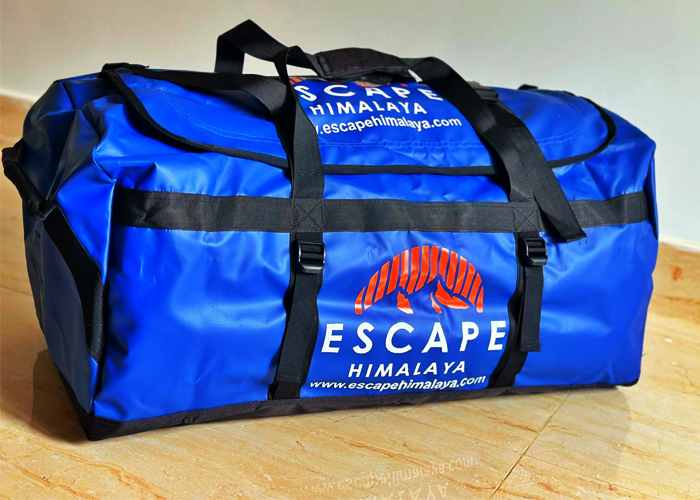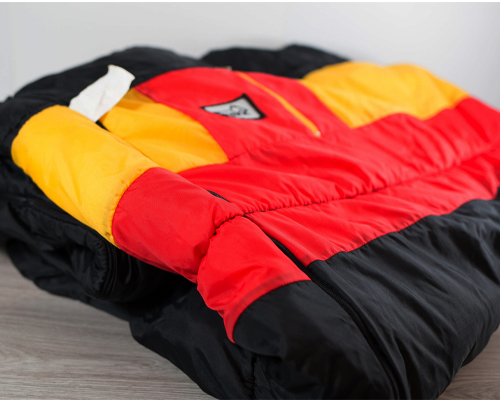Proper trekking equipment is vital for traveling around the Himalayas. Whether you're going on a day hike or a month-long expedition, you should be thoughtful about packing the right gear before starting an adventure.
We suggest you use the best quality gear for trekking in Nepal. Likewise, it is crucial to keep your luggage light, given that our porters can carry up to 25 kilograms for two trekkers.
Complimentary Gear for Trekking Days
We provide a top-of-the-line 120-liter Duffel Bag for efficient trek packing, a certified -20°C Down Jacket for ultimate cold protection, and a high-quality four-season Sleeping Bag, ensuring unparalleled warmth and coziness during even the chilliest mountain nights.



Trekking Duffel Bag
A duffle bag, also known as a kit bag, is a cylindrical-shaped carrying bag with a top closure generally made of natural or sturdy fabric (usually canvas). It has a handle or shoulder strap to carry, making it easy for the porter to carry it. Duffle bags are commonly used for traveling, sports, outdoor activities, or temporary storage. They are used for carrying clothing, personal items, and electronics or sports gear during travel. The size of the duffle bag varies according to one's needs and requirements. They come in different sizes, from small to large travel duffle bags, and are capable of holding required gear during travel. Generally, duffle bags are used to carry loads up to 15 kg in all treks, which vary according to the size and materials to be carried during the travel and the porter's carrying limit. Duffle bags are suitable for trekking due to their comfort and accessibility as they are flexible and portable, which makes them easy to carry. It is an excellent choice to carry for traveling due to its versatility and ease of handling.
We arrange the duffle bags that hold up to 120 liters of storage capacity and are also waterproof, which helps in the rainy environment by protecting the materials inside the bag. Generally, the porter carries these duffle bags during the trek. Bring a small or medium carrying bag with personal materials and gadgets. Please remember that your luggage and suitcase will be securely managed and safeguarded at our hotel while you enjoy your trek, and we will quickly return to you once you complete your trek.
At Escape Himalaya, we provide a meticulously crafted checklist of essential trekking gear. This is our way of ensuring you're fully equipped for your Himalayan adventure, backed by our expertise and care in selecting the right gear for you.
Down Jacket
A down jacket, also known as a puffer jacket, is a quilted coat filled with soft feathers from a duck or goose. It's a popular choice for cold climates and higher altitudes due to its excellent warmth-to-weight ratio. Hikers, trekkers, and backpackers prefer them for their extreme comfort, lightweight, and compressibility, making them easy to pack without taking up much space. The down jacket we provide is ideal for wearing and sleeping during high-altitude treks, providing excellent insulation and comfort. Please return it once the trek is completed to preserve it for the next adventurers.
It is also ideal for wearing and sleeping during high-altitude treks, providing excellent insulation and comfort. Please return it once the trek is completed to preserve it for the next adventures.
We arrange the duffle bags that hold up to 120 liters of storage capacity and are also waterproof, which helps in the rainy environment by protecting the materials inside the bag. Generally, the porter carries these duffle bags during the trek. You can take a small or medium carrying bag with personal materials and gadgets. Please remember that your luggage and suitcase will be securely managed and safeguarded at our hotel while you enjoy your trek, and we will quickly return to you once you complete your trek.
Sleeping Bag
Sleeping bags are essential gear for travelers and trekkers. They provide good comfort and protection in various climatic conditions and altitudes. Most of our treks and tours require a sleeping bag, which keeps you warm by trapping the heat around your body.
The sleeping bags we use are mummy-shaped, with a zip that opens and closes, keeping the top tight around you. They are used in cold and wet climates at high altitudes (-20°C to -25°C maximum temperature), giving you protection and comfort. They are also lightweight and compact, making them easy to carry on long treks. The sleeping bag is returned after the trek, helping us maintain our gear for future adventurers.
Equipment Checklist to Pack for Your Trek in Nepal
For a trek in Nepal during Spring (March to May) and Autumn (September to November), here is our suggested Equipment Checklist:
CLOTHING:
- Lightweight and moisture-wicking base layers
- Insulating layers for colder mornings and evenings
- Waterproof and windproof jacket
- Trekking pants and shorts
- Long-sleeved shirts and T-shirts
- Fleece or down jacket for higher altitudes
FOOTWEAR:
- Sturdy and comfortable trekking boots with good ankle support
- Lightweight and breathable trekking socks
- Gaiters (Optional)
HEADWEAR:
- Wide-brimmed hat or cap for sun protection
- Warm beanie or hat for colder temperatures
- Sunglasses with UV protection
GEAR AND ACCESSORIES:
- Backpack with rain cover
- Trekking poles for stability
- Water purification tablets or the water filter
- Headlamp or flashlight with extra batteries
- Personal first aid kit
WEATHER PROTECTION:
- Sunscreen with high SPF
- Lip balm with UV protection
- Rain covers or waterproof covers for your backpack
- Lightweight and quick-drying towel
PERSONAL ITEMS:
- Identification documents and necessary permits
- Lightweight and quick-drying towel
- Personal hygiene items (toothbrush, toothpaste, etc.)
Likewise, For Winter (December to February) treks in Nepal, you can upgrade to these recommended gear:
In addition to the items mentioned above, consider the following for winter trekking:
CLOTHING:
- Insulated and waterproof gloves
- Insulated and waterproof pants
- Additional warm layers, including thermal underwear
FOOTWEAR:
- Insulated and waterproof trekking boots
- Thick and warm trekking socks
HEADWEAR:
- Neck gaiter or scarf for added warmth
GEAR AND ACCESSORIES:
- Four-season sleeping bag for colder temperatures
- Crampons for icy and snowy sections
- Ice axe for additional stability in icy conditions
WEATHER PROTECTION:
- Additional cold-weather skincare items (cold cream, moisturizer)
Always check the specific weather conditions and requirements for the time of year you plan to trek, and you can ask us for the most up-to-date recommendations.




